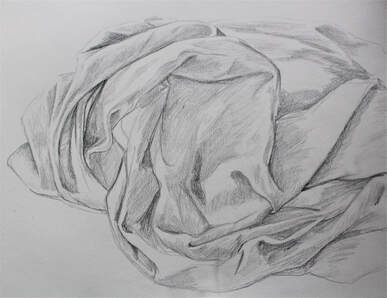Draped fabric life drawing

Any great drawing needs to start with an accurate sketch. If the sketch isn’t correct your drawing just isn’t going to turn out looking right. I gently sketched out the main shape of the cloth with a mechanical pencil. Remember to press lightly and use a sharp pencil that can be easily erased. That way you can adjust your drawing multiple times to get it right before going on to the shading

During this next stage I used a HB pencil and lightly shaded all the dark areas. Make sure not to go too dark at first so that your drawing can still be adjusted as needed. Remember that cloth will have rounded edges and that you will need to shade it like you would a ball. Keep in mind the core shadows, cast shadows, and reflected light.

Next, I used a 6B wood-less graphite pencil to get some of the darkest values on the cloth. As you can see the dark pencil tends to lay on top of the paper and leaves a rough or grainy texture.

I blended the rough texture with a paper blending tool to give the cloth a softer texture. Then, I went back over the darker areas with a HB pencil to blend and darken.

The last stage is always the hardest, so, don’t give up! Remember that your eraser can be as important as your pencils. Use a kneaded eraser to remove any smudges and lighten highlights. Then use your 6B pencil to go over the darker areas again and add some cast shadows. Darkening the negative shape behind your object can make it pop into the foreground.
http://aspencreekart.com/author/cherithaspencreekart-com/
Essential question: What are the four shapes fabric folds are made of? How does light play a role with fabric?
How will we know if they’ve learned it?
Students will have a finished piece of art that can be considered for various competitions
What will we do if they don’t learn it?
Students will be re-taught and can utilized videos to re-work missing elements of their assignment.
What will we do if they have / have already learned?
Students can always go above and beyond the instructions to create a more challenging experience.
My students understand and can… by the end of the lesson
Understand chiaroscuro and how to use extreme contrast for fabric folds, they will know how to layer and blend different lead pencils.
Teks: 117.C ((2) Creative expression. The student communicates ideas through original artwork using a variety of media with appropriate skills. The student expresses thoughts and ideas creatively while challenging the imagination, fostering reflective thinking, and developing disciplined effort and progressive problem-solving skills. The student is expected to: (A) use visual solutions to create original artwork by problem solving through direct observation, original sources, experiences, narrations, and imagination; (B) communicate a variety of applications for design solutions; (C) use an understanding of copyright and public domain to appropriate imagery constituting the main focal point of original artwork when working from images rather than direct observation or imagination; (D) create original artwork to communicate thoughts, feelings, ideas, or impressions;
use an understanding of copyright and public domain to appropriate imagery constituting the main focal point of original artwork when working from images rather than direct observation or imagination;
How will we know if they’ve learned it?
Students will have a finished piece of art that can be considered for various competitions
What will we do if they don’t learn it?
Students will be re-taught and can utilized videos to re-work missing elements of their assignment.
What will we do if they have / have already learned?
Students can always go above and beyond the instructions to create a more challenging experience.
My students understand and can… by the end of the lesson
Understand chiaroscuro and how to use extreme contrast for fabric folds, they will know how to layer and blend different lead pencils.
Teks: 117.C ((2) Creative expression. The student communicates ideas through original artwork using a variety of media with appropriate skills. The student expresses thoughts and ideas creatively while challenging the imagination, fostering reflective thinking, and developing disciplined effort and progressive problem-solving skills. The student is expected to: (A) use visual solutions to create original artwork by problem solving through direct observation, original sources, experiences, narrations, and imagination; (B) communicate a variety of applications for design solutions; (C) use an understanding of copyright and public domain to appropriate imagery constituting the main focal point of original artwork when working from images rather than direct observation or imagination; (D) create original artwork to communicate thoughts, feelings, ideas, or impressions;
use an understanding of copyright and public domain to appropriate imagery constituting the main focal point of original artwork when working from images rather than direct observation or imagination;




